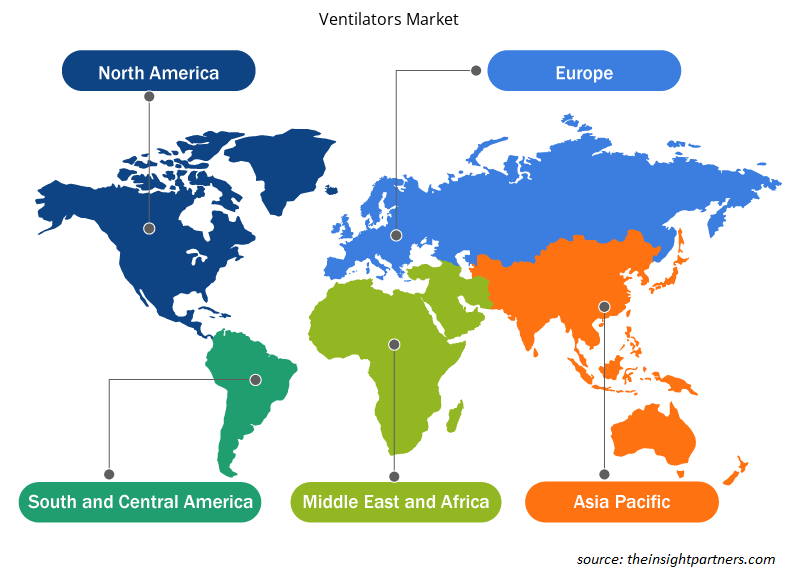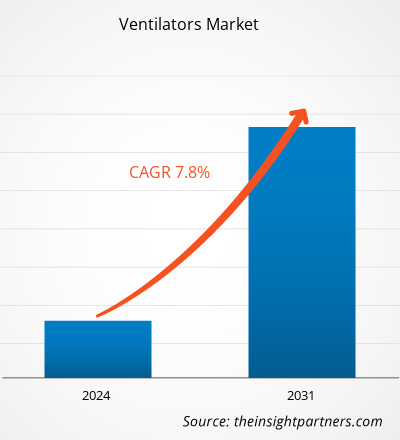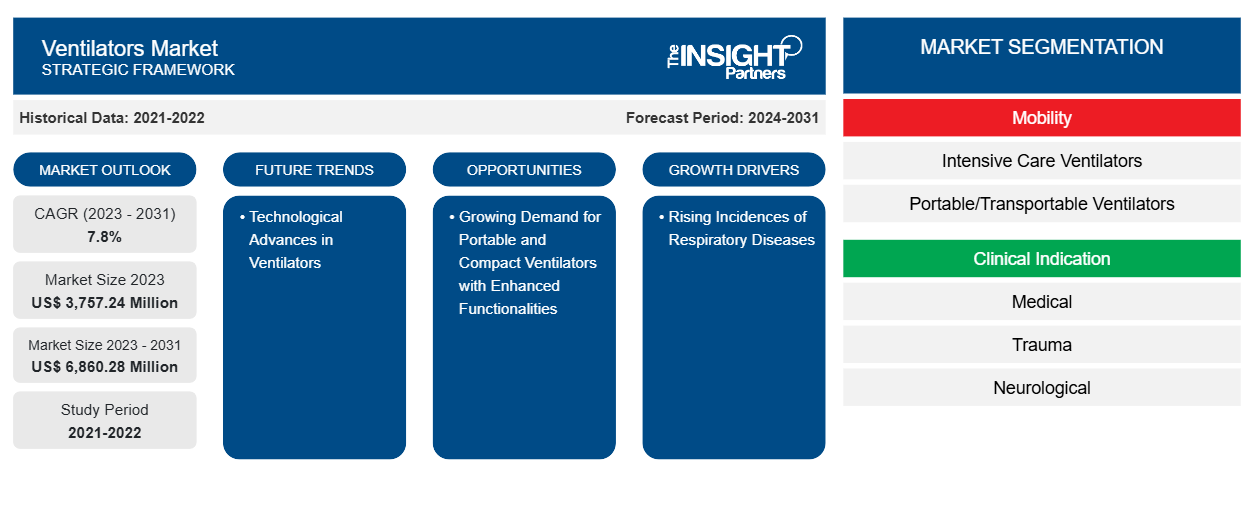Der Markt für Beatmungsgeräte soll von 3.757,24 Millionen US-Dollar im Jahr 2023 auf 6.860,28 Millionen US-Dollar im Jahr 2031 anwachsen. Der Markt wird zwischen 2023 und 2031 voraussichtlich eine durchschnittliche jährliche Wachstumsrate von 7,8 % verzeichnen. Die wachsende Nachfrage nach tragbaren und kompakten Beatmungsgeräten mit erweiterten Funktionen dürfte einer der wichtigsten Trends auf dem Markt sein.
Marktanalyse für Beatmungsgeräte
Faktoren, die das Wachstum des Beatmungsgerätemarktes vorantreiben, sind die zunehmende Zahl chronisch obstruktiver Lungenerkrankungen ( COPD ), Atemnotfälle und technologische Fortschritte bei Geräten zur Atemtherapie. Die Einführung patientenfreundlicher, kostengünstiger und tragbarer Geräte treibt die Nutzung von Beatmungsgeräten weiter voran und führt so zu einem Marktwachstum. Darüber hinaus wird erwartet, dass staatliche Förderinitiativen, die eine sichere, erschwingliche und qualitativ hochwertige Gesundheitsversorgung bieten sollen, die Nachfrage nach Beatmungsgeräten im Prognosezeitraum erhöhen werden. Verschiedene Marktteilnehmer auf dem Beatmungsgerätemarkt bieten Beatmungsgeräte an, was das Wachstum des Beatmungsgerätemarktes wahrscheinlich ankurbeln wird. Hamilton Medical bietet Beatmungsgeräte namens HAMILTON-C1 und Hamilton-C1 neo an , ein Beatmungsgerät für Neugeborene, das eine Reihe von Therapieoptionen mit Mobilität in einem Beatmungsgerät kombiniert, das speziell für Neugeborene entwickelt wurde.
Marktübersicht für Beatmungsgeräte
Der Markt wird durch eine Zunahme älterer Menschen, die anfällig für Atemwegserkrankungen sind, wachsende Fortschritte in der Gesundheitsinfrastruktur und eine stärkere Nutzung fortschrittlicher Technologien angetrieben. Ältere Menschen sind aufgrund altersbedingter Probleme wie Gebrechlichkeit anfälliger für schwere Krankheiten durch Atemwegsinfektionen als jüngere Menschen, was die Zahl der Krankenhausaufenthalte und Todesfälle erhöht. Die Zunahme der älteren Bevölkerung hat zu einem Anstieg geriatrischer Erkrankungen geführt, was zu einem enormen Bedarf an Intensivpflege, einschließlich mechanischer Beatmung, führt. Laut der Datenbank 2020 der Centers for Disease Control and Prevention (CDC) ist die Zahl der COPD -Patienten und -Todesfälle in älteren Altersgruppen viel höher und trägt zu 86 % der COPD- Todesfälle in diesen Altersgruppen bei. Das Alter ist der Hauptfaktor, der zur Zunahme der Fälle chronisch-degenerativer Erkrankungen beiträgt. In einigen Fällen führt es dazu, dass Eingriffe erforderlich sind, die eine Aufnahme auf Intensivstationen erfordern . Daher fördert das schnelle Wachstum der geriatrischen Bevölkerung die Nachfrage nach Beatmungsunterstützung, was das Wachstum des Beatmungsmarktes ankurbelt.
Passen Sie diesen Bericht Ihren Anforderungen an
Sie erhalten kostenlose Anpassungen an jedem Bericht, einschließlich Teilen dieses Berichts oder einer Analyse auf Länderebene, eines Excel-Datenpakets sowie tolle Angebote und Rabatte für Start-ups und Universitäten.
-
Holen Sie sich die wichtigsten Markttrends aus diesem Bericht.Dieses KOSTENLOSE Beispiel umfasst eine Datenanalyse von Markttrends bis hin zu Schätzungen und Prognosen.
Treiber und Chancen auf dem Beatmungsgerätemarkt
Steigende Fälle von Atemwegserkrankungen begünstigen das Marktwachstum
COPD , Asthma, akute Infektionen der unteren Atemwege, Tuberkulose, Lungenkrebs und andere Atemwegserkrankungen gehören weltweit zu den häufigsten Ursachen für schwere Erkrankungen und Todesfälle. Laut den Daten der American Lung Association aus dem Jahr 2023 leiden etwa 34 Millionen Amerikaner an chronischen Lungenerkrankungen wie Asthma und COPD . Laut dem Office of Disease Prevention and Health Promotion wurden im Jahr 2020 in den USA etwa 14,8 Millionen Erwachsene mit COPD diagnostiziert . Ein Beatmungsgerät unterstützt den von Atemwegserkrankungen oder anderen derartigen Leiden betroffenen Patienten beim Atmen. Daher erfordert die Behandlung von Atemwegserkrankungen eine mechanische Beatmung. Somit unterstützt die zunehmende Belastung durch Atemwegserkrankungen die Nachfrage nach Beatmungsgeräten und treibt so das Marktwachstum voran.
Technologische Fortschritte bei Beatmungsgeräten
Die Nachfrage nach innovativen, kleineren, leiseren und komfortableren Beatmungsgeräten, die auf die Bedürfnisse der Patienten eingehen und es Gesundheitsdienstleistern ermöglichen, Patienten auf der Intensivstation effektiv zu behandeln, steigt. In den letzten zwei Jahrzehnten haben technische Verbesserungen die Leistung von Beatmungsgeräten auf Intensivstationen erheblich verbessert. Mit der Weiterentwicklung von Beatmungsgeräten auf Intensivstationen sind zusätzliche Modi leicht verfügbar und die Benutzeroberfläche wurde geändert. Die meisten Beatmungsgeräte der neuen Generation auf Intensivstationen verfügen über einen Computerbildschirm, der die Benutzeroberfläche, automatische Entwöhnungsstrategien und die Synchronisierung der Beatmungsgeräte steuert. Darüber hinaus sind tragbare Beatmungsgeräte eine neue technologische Weiterentwicklung bei Beatmungsgeräten. Die kompakte Größe des Geräts dürfte die Beatmungspflege verändern, indem sie Tragbarkeit, Benutzerfreundlichkeit, Vielseitigkeit und eine längere Akkulaufzeit bietet. Es ist weniger teuer als andere Beatmungsgeräte auf Intensivstationen und verfügt sowohl über invasive als auch nicht-invasive Funktionen. Daher wird erwartet, dass der wachsende Beatmungssektor dem Markt Wachstumschancen bietet.
Segmentierungsanalyse des Marktberichts für Beatmungsgeräte
Wichtige Segmente, die zur Ableitung der Marktanalyse für Beatmungsgeräte beigetragen haben, sind Mobilität, klinische Indikation, Schnittstelle, Patienten, Modus und Endbenutzer.
- Basierend auf der Mobilität wird der Beatmungsgerätemarkt in Beatmungsgeräte für die Intensivpflege und tragbare/transportable Beatmungsgeräte unterteilt. Das Segment der Beatmungsgeräte für die Intensivpflege hatte im Jahr 2023 den größten Marktanteil. Das Segment der tragbaren/transportablen Beatmungsgeräte wird im Prognosezeitraum voraussichtlich die höchste durchschnittliche jährliche Wachstumsrate verzeichnen.
- In Bezug auf die klinische Indikation wird der Markt in medizinische, traumatische, neurologische, chirurgische und andere Bereiche unterteilt. Das medizinische Segment hatte im Jahr 2023 den größten Marktanteil. Das neurologische Segment wird im Prognosezeitraum voraussichtlich die höchste durchschnittliche jährliche Wachstumsrate verzeichnen.
- Basierend auf den Patienten ist der Markt für Beatmungsgeräte in Erwachsene sowie Kinder und Neugeborene unterteilt. Das Erwachsenensegment hatte im Jahr 2023 einen größeren Marktanteil und wird im Prognosezeitraum voraussichtlich eine höhere durchschnittliche jährliche Wachstumsrate verzeichnen.
- Basierend auf der Schnittstelle ist der Markt für Beatmungsgeräte in invasiv und nicht-invasiv unterteilt. Das invasive Segment hatte im Jahr 2023 einen größeren Marktanteil. Das nicht-invasive Segment dürfte im Prognosezeitraum eine höhere durchschnittliche jährliche Wachstumsrate verzeichnen.
- In Bezug auf den Modus ist der Markt segmentiert in kombinierte Beatmung, Volumenbeatmung, Druckbeatmung, neuronal angepasste Beatmungshilfen, inverse Verhältnisbeatmung, Bauchlagebeatmung, hochfrequente oszillatorische Beatmung, hochfrequente perkussive Beatmung und andere. Das Segment der kombinierten Beatmung hatte 2023 den größten Marktanteil und wird im Prognosezeitraum voraussichtlich die schnellste CAGR verzeichnen.
- Basierend auf dem Endverbraucher ist der Markt in Krankenhäuser und Kliniken, häusliche Pflege, ambulante Pflegezentren und Notfalldienste segmentiert. Das Segment Krankenhäuser und Kliniken hielt im Jahr 2023 den größten Marktanteil und wird im Prognosezeitraum voraussichtlich die schnellste CAGR verzeichnen.
Marktanteilsanalyse für Beatmungsgeräte nach geografischer Lage
Der geografische Umfang des Marktberichts für Beatmungsgeräte ist hauptsächlich in fünf Regionen unterteilt: Nordamerika, Asien-Pazifik, Europa, Naher Osten und Afrika sowie Süd- und Mittelamerika.
Nordamerika dominiert den Markt für Beatmungsgeräte. Das Wachstum des Marktes in dieser Region ist auf die zunehmende Konzentration der Marktteilnehmer in den USA und Kanada, die hohe Prävalenz von Atemwegserkrankungen, die zunehmende geriatrische Bevölkerung, die hohe Prävalenz des Rauchens, das hoch entwickelte Gesundheitssystem und die steigenden Gesundheitsausgaben zurückzuführen. Laut den im November 2022 veröffentlichten Bronchitis Facts and Statistics ist Bronchitis ein häufiger Grund für die Krankenhauseinweisung von Erwachsenen in den USA. Etwa 1 von 20 Erwachsenen in den USA leidet jährlich an akuter Bronchitis, und ∼10 Millionen Menschen (d. h. 3 % der Bevölkerung) sind von chronischer Bronchitis betroffen. Darüber hinaus schätzt die Canadian Nurse Association, dass ~3 Millionen Kanadier an einer der schweren Atemwegserkrankungen wie Asthma, COPD, Lungenkrebs, Mukoviszidose, Schlafapnoe und berufsbedingten Lungenerkrankungen leiden. Darüber hinaus wird erwartet, dass der asiatisch-pazifische Raum in den kommenden Jahren mit der höchsten CAGR wachsen wird.COPD, lung cancer, cystic fibrosis, sleep apnea, and occupational lung diseases. Further, Asia Pacific is anticipated to grow with the highest CAGR in the coming years.
Regionale Einblicke in den Markt für Beatmungsgeräte
Die regionalen Trends und Faktoren, die den Beatmungsgerätemarkt während des Prognosezeitraums beeinflussen, wurden von den Analysten von Insight Partners ausführlich erläutert. In diesem Abschnitt werden auch die Beatmungsgerätemarktsegmente und die Geografie in Nordamerika, Europa, im asiatisch-pazifischen Raum, im Nahen Osten und Afrika sowie in Süd- und Mittelamerika erörtert.

- Erhalten Sie regionale Daten zum Beatmungsgerätemarkt
Umfang des Marktberichts zu Beatmungsgeräten
| Berichtsattribut | Details |
|---|---|
| Marktgröße im Jahr 2023 | 3.757,24 Millionen US-Dollar |
| Marktgröße bis 2031 | 6.860,28 Millionen US-Dollar |
| Globale CAGR (2023 - 2031) | 7,8 % |
| Historische Daten | 2021-2022 |
| Prognosezeitraum | 2024–2031 |
| Abgedeckte Segmente |
Von Mobility
|
| Abgedeckte Regionen und Länder |
Nordamerika
|
| Marktführer und wichtige Unternehmensprofile |
|
Marktteilnehmerdichte für Beatmungsgeräte: Auswirkungen auf die Geschäftsdynamik verstehen
Der Markt für Beatmungsgeräte wächst rasant. Dies wird durch die steigende Nachfrage der Endnutzer aufgrund von Faktoren wie sich entwickelnden Verbraucherpräferenzen, technologischen Fortschritten und einem größeren Bewusstsein für die Vorteile des Produkts vorangetrieben. Mit der steigenden Nachfrage erweitern Unternehmen ihr Angebot, entwickeln Innovationen, um die Bedürfnisse der Verbraucher zu erfüllen, und nutzen neue Trends, was das Marktwachstum weiter ankurbelt.
Die Marktteilnehmerdichte bezieht sich auf die Verteilung der Firmen oder Unternehmen, die in einem bestimmten Markt oder einer bestimmten Branche tätig sind. Sie gibt an, wie viele Wettbewerber (Marktteilnehmer) in einem bestimmten Marktraum im Verhältnis zu seiner Größe oder seinem gesamten Marktwert präsent sind.
Die wichtigsten auf dem Beatmungsgerätemarkt tätigen Unternehmen sind:
- Vyaire Medical Inc
- Getinge AB
- Drägerwerk AG & Co. KGaA
- Fisher und Paykel Healthcare
- GE-Gesundheitswesen
- Hamilton Medical
Haftungsausschluss : Die oben aufgeführten Unternehmen sind nicht in einer bestimmten Reihenfolge aufgeführt.

- Überblick über die wichtigsten Akteure auf dem Beatmungsgerätemarkt
Neuigkeiten und aktuelle Entwicklungen zum Beatmungsgerätemarkt
Der Markt für Beatmungsgeräte wird durch die Erhebung qualitativer und quantitativer Daten nach Primär- und Sekundärforschung bewertet, die wichtige Unternehmensveröffentlichungen, Verbandsdaten und Datenbanken umfasst. Nachfolgend sind einige der Entwicklungen auf dem Markt für Beatmungsgeräte aufgeführt:
- Getinge hat sein neues mechanisches Beatmungsgerät Servo-c für ausgewählte Märkte auf den Markt gebracht und bietet lungenschonende Therapieinstrumente zur Behandlung von Kindern und Erwachsenen. Servo-c soll die Gesundheitsversorgung für mehr Krankenhäuser auf der ganzen Welt zugänglich und erschwinglich machen. (Quelle: Getinge, Pressemitteilung, Januar 2023)
- Max Ventilator hat multifunktionale nicht-invasive (NIV) Beatmungsgeräte auf den Markt gebracht, die mit integrierter Sauerstofftherapie und einem Luftbefeuchter ausgestattet sind. Das neue Produkt des Unternehmens ist einfach zu bedienen, leicht und verfügt über einzigartige multifunktionale Funktionen. Ein herausragendes Merkmal des Geräts, das es in einer Intensivstation hervorstechen lässt, ist die spezielle Vorrichtung zum Anschluss dieses Geräts an eine „Absaugleitung“. (Quelle: Max Ventilator, Pressemitteilung, Mai 2022)
Marktbericht zu Beatmungsgeräten: Umfang und Ergebnisse
Der Bericht „Marktgröße und Prognose für Beatmungsgeräte (2021–2031)“ bietet eine detaillierte Analyse des Marktes, die die folgenden Bereiche abdeckt:
- Marktgröße und Prognose für Ventilatoren auf globaler, regionaler und Länderebene für alle wichtigen Marktsegmente, die im Rahmen des Berichts abgedeckt sind
- Markttrends für Beatmungsgeräte sowie Marktdynamiken wie Treiber, Einschränkungen und wichtige Chancen
- Detaillierte PEST- und SWOT-Analyse
- Marktanalyse für Beatmungsgeräte, die wichtige Markttrends, globale und regionale Rahmenbedingungen, wichtige Akteure, Vorschriften und aktuelle Marktentwicklungen umfasst
- Branchenlandschaft und Wettbewerbsanalyse, einschließlich Marktkonzentration, Heatmap-Analyse, prominenten Akteuren und jüngsten Entwicklungen auf dem Beatmungsgerätemarkt
- Detaillierte Firmenprofile
- Historische Analyse (2 Jahre), Basisjahr, Prognose (7 Jahre) mit CAGR
- PEST- und SWOT-Analyse
- Marktgröße Wert/Volumen – Global, Regional, Land
- Branchen- und Wettbewerbslandschaft
- Excel-Datensatz
Aktuelle Berichte
Erfahrungsberichte
Grund zum Kauf
- Fundierte Entscheidungsfindung
- Marktdynamik verstehen
- Wettbewerbsanalyse
- Kundeneinblicke
- Marktprognosen
- Risikominimierung
- Strategische Planung
- Investitionsbegründung
- Identifizierung neuer Märkte
- Verbesserung von Marketingstrategien
- Steigerung der Betriebseffizienz
- Anpassung an regulatorische Trends























 Kostenlose Probe anfordern für - Markt für Beatmungsgeräte
Kostenlose Probe anfordern für - Markt für Beatmungsgeräte